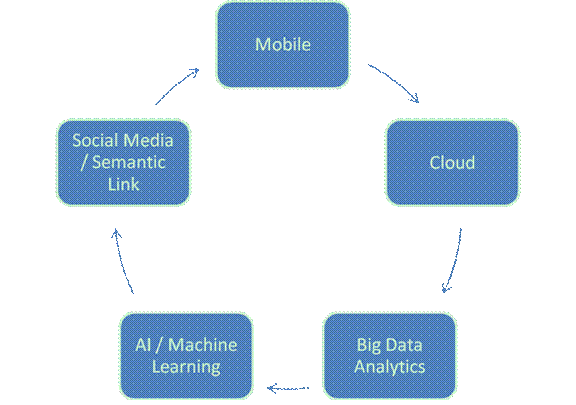>
SOURCE: www.outsourcing-journal.org
By Albert Ma, Chief Innovation Officer at Insigma Hengtian, Hangzhou, China.
IT silos are not difficult to find in the business world. New technology continues to emerge from the market – technology that has been treated in a fragmented fashion rather than holistically. If we take an in-depth look at today’s disruptive technologies, such as cloud computing, mobile data and big data, this concept is not new. Each of these technologies greatly influences how businesses are run. Moreover, combining them into turnkey solutions can even generate exponential benefits for businesses, but they require a very different school of thought in constructing the application software.
The mobile phone is a good example, in that it’s a whole new way of delivering information to an end user. Features like geo-location and accelerometers are not commonly found on traditional devices, and require a whole new set of rules when designing software. Furthermore, mobile phones are not just bound by the software on which they run – they must also work with the Internet. This generates another set of cloud computing needs, which must be mobile friendly in bi-directional communications. The chain effect does not stop here. With more frequent end users who are well-connected in the cloud (e.g. social media) big data analytics become a driving force in many business decisions. Nowadays, it is not uncommon to see or Wall Street analysts or any company’s marketing department mining dating on the Internet in order to predict where the potential customers or potential stock investment opportunities are.
Opportunity exists because most of the legacy systems running in today’s corporate data centers are neither mobile-friendly nor service-oriented. Redundant business functions with lengthy and costly support cycles drive down the competiveness of old-fashioned business models. Today’s application needs a fundamental revamp to support three basic constituents (i.e., Hengtian’s CSA model):
Connect: Mobile-driven with the capability of connecting to a large number of end users simultaneously (both customers and non-customers)
Share: User-centric design with strong support in real time bi-directional communications (personal or group sharing)
Adapt: Built-in intelligence that allow software to better handle personalization and customization (self-learning)
Taking a holistic view of all these disruptive technologies, it is easy to see the critical need for system refactoring / reengineering in the coming years. The key, however, lies in how a new set of software engineering principles and tools can be evolved to embrace these technologies in application software development.

The Connect - Share - Adapt Model
Outsourcing vendors not only need to master the latest technologies, but also need to provide value-added services to their customers in modernizing applications. However, manually re-factoring such applications to cater to the new architectural design may not initially have the most suitable return on investment (ROI). Therefore, vendors must leverage automation tools (such as Hengtian’s BlueMorpho) to:
- Analyze
- Translate
- Transform
an application from one language to another (e.g. COBOL to java), and from one platform to another (e.g. two tiered architecture to multi-tenancy cloud computing).
With decades of development, IT outsourcing has reached a certain maturity level that requires service providers to leverage their innovation ability to maintain a competitive edge. With the explosive adoption of mobile, cloud, and big data analytics in the coming years, there is a big question mark, yet huge opportunities exist for IT outsourcing vendors to expand their horizons beyond the old fashioned business models.
Introduction to Albert Ma
Albert Ma is the Chief Innovation Officer of Insigma Hengtian, located in Hangzhou, China. Before he joined Hengtian, Albert was the Chief Information Officer of State Street Hangzhou, managing most of the mission critical applications. Albert has engaged with outsourcing businesses for decades, and is enthusiastic about the current and future technological innovations reshaping the IT industry. He can be reached by e-mail at
albertma@hengtiansoft.com.
To read the whole journal:
https://app.box.com/s/dykl3m1p1r0iy72hgx4c
